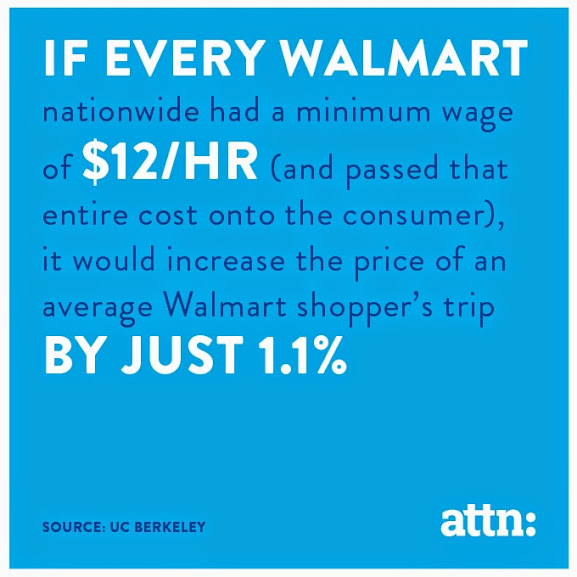Here's How Much You'll Pay Extra If Walmart Raises Their Wages
By:
In the wake of nationwide protests over low wages and poor working conditions, Sen. Patty Murray (D-Wash.) recently corralled many of her fellow lawmakers to introduce legislation that would raise the federal minimum wage from $7.25 to $12 an hour.
"No one who works hard in a full-time job should have to live in poverty," she said in a statement arguing for the legislation. "We owe it to workers across the country to make sure our minimum wage is set to a level that works for them and their families."
However, one of the core arguments against a $12 minimum wage (or higher minimum wage in general) is that the increase in overhead will force employers to shift costs to consumers in the form of higher prices, hurting the very people who need affordable goods and services the most.
It just so happens that a 2011 study from UC-Berkeley examined this, calculating the effect of a wage hike to $12 at Walmart, the nation's largest private employer, and the results are fascinating.
- According to researchers Ken Jacobs, Dave Graham-Squire, and Stephanie Luce, 41.4 percent of a pay increase to $12 an hour would go to workers in families with total incomes below 200 percent of the federal poverty level.
- The researches conclude that even if Walmart were to pass 100 percent of a $12 wage increase to consumers, its average impact on a Walmart shopper would be negligible: it would raise prices only 1.1 percent.
- This 1.1 percent increase in price works out to $0.46 per shopping trip, or $12.49 per year, for the average consumer who spends approximately $1,187 per year at Walmart.
 ATTN.com
ATTN.com
As the study's authors note, this 1.1 percent increase in prices calculates only the maximum scenario as it does not account for the possibility that a wage hike could be subsumed through other means. "Part of the cost could be absorbed through accepting a lower profit margin; leveling or reducing management salaries and bonuses; and through improved labor productivity due to increased effort, lower turnover, and lower absenteeism," the researchers explain.
You are subsidizing Walmart.
According to a report from Americans for Tax Fairness, a non-profit that advocates for tax reform, American consumers subsidize Walmart to the tune of $6.2 billion per year through public assistance. This is because Walmart pays a huge share of its workforce low wages, which requires them to rely on food stamps, low income housing, and other taxpayer funded welfare programs.
Do you know what food stamps and what you can purchase with them? Here is a quick video explainer:
Slate and Marketplace released this video examining the relationship between Walmart and the food stamp system. Its analysis looked at the state of Ohio and found that approximately 15 percent of Walmart workers throughout the state use food stamps, which equates to about 40 employees per store.
A report from the Democratic staff at the U.S. House Committee on Education and the Workforce also found that "a single 300-employee Wal-Mart Supercenter in Wisconsin may cost taxpayers anywhere from $904,542 to nearly $1.75 million per year, or about $5,815 per employee."
As ATTN: wrote recently, Walmart is double-dipping into your wallet in the sense that they command about 18 percent of the food stamp market. Americans for Tax Fairness uses this figure to estimate that Walmart accounted for 13.5 billion of the $76 billion food stamp market in 2013.
